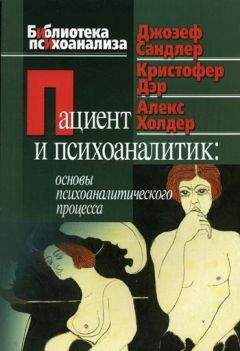Джозеф Сандлер - Пациент и психоаналитик: основы психоаналитического процесса
Следует заметить в заключение, что большинство авторов работ по психоанализу утверждают, что, хотя проработка является существенной частью психоаналитического процесса, интерпретация бессознательного ментального содержания и повторение переноса вместе с достижением инсайта в равной степени жизненно важны для анализа. Таким образом, любые методы, которые не используют все эти элементы, не должны рассматриваться как психоаналитические. Однако, это не означает, что проработка не может играть роли в других формах терапии, в частности, тех, которые включают в себя элемент «переподготовки» или «переобучения».
ЛИТЕРАТУРА
ABEND, S.M. (1982). Serious illness in the analyst: countertransference considerations // Journal of the American Psychoanalytic Association 30, 365—379.
ABEND, S.M. (1986). Countertransference, empathy, and the analytic ideal: the impact of life stresses on analytic capability // Psychoanalytic Quarterly, 55, 563—575.
ABEND, S.M. (1988). Neglected classics: Ernst Kris’s «On some vicissitudes of insight in psycho-analysis» // Psychoanalytic Quarterly, 57, 224– 228.
ABEND, S.M., PORDER, M., WILLICK, M.S. (1983). Borderline Patients: Psychoanalytic Perspectives. – N.Y.: International Universities Press.
ABRAHAM, K. (1908). The psycho-sexual differences between hysteria and dementia praecox // Selected Papers on Psycho-Analysis. – Lndn.: Hogarth Press, 1927. [Reprinted Lndn: Karnac Books, 1979.]
ABRAHAM, K. (1919). A particular form of neurotic resistance against the psychoanalytic method // Selected Papers on Psycho-Analysis. – Lndn.: Hogarth Press, 1927. [Reprinted Lndn: Karnac Books, 1979.]
ABT, L., WEISSMAN, S. (Eds.) (1965). Acting Out: Theoretical and Clinical Aspects. – N.Y.: Grune & Stratton.
ABT, L, WEISSMAN, S. (Eds.) (1976). Acting Out: Theoretical and Clinical Aspects. – N.Y.: Grune & Stratton. – 2-ое изд.
ADLER, G. (1980). Transference, real relationship, and alliance // International Journal of Psycho-Analysis, 61: 547—558.
ADLER, G. (1981). The borderline-narcissistic personality disorder continuum // American Journal of Psychiatry, 138: 46—50.
ADLER, G. (1984). Issues in the treatment of the borderline patient // P.E. Stepansky & A. Goldberg (Eds.), Kohut’s Legacy: Contributions to Self Psychology. – Hillsdale, NJ: Analytic Press.
ADLER, G. (1985). Borderline Psychopathology and its Treatment. – N.Y.: Jason Aronson.
ADLER, G. (1989). Transitional phenomena, projective identification and the essential ambiguity of the psychanalytic situation // Psychoanalytic Quarterly, 58, 81—104.
ADLER, G., BUIE, D.H. (1979). Aloneness and borderline psychopathology: the possible relevance of child development issues // International Journal of Psycho-Analysis, 60: 83—96.
ALEXANDER, F. (1925). A metapsychological description of the process of cure // International Journal of Psycho-Analysis, 6: 13—34.
ALEXANDER, F. (1948). Fundamentals of Psychoanalysis. – N.Y.: Norton.
ALEXANDER, F. (1950). Analysis of the therapeutic factors in psychoanalytic treatment // Psychoanalytic Quarterly, 19, 482—500.
ALEXANDER, F., FRENCH, T. M. (1946). Psychoanalytic Therapy. – N.Y.: Ronald Press.
ANASTASOPOULOS, D. (1988). Acting out during adolescence in terms of regression in symbol formation // International Review of Psychoanalysis, 15: 177—185.
ARKIN, F.S. (1960). Discussion of Salzman, L., The negative therapeutic reaction // J.H. Masserman (Ed.), Science and Psychoanalysis. – Vol. 3. – N.Y.: Grune & Stratton. – Pp. 314—317.
ARLOW, J.A. (1985). Some technical problems of countertrancference // Psychoanalytic Quarterly, 54, 164—174.
ARLOW, J.A. (1987). The dynamics of interpretation // Psychoanalytic Quarterly, 56, 68—87.
ARLOW, J.A., BRENNER, C. (1964). Psychoanalytic Concepts and the Structural Theory – N.Y.: International Universities Press.
ARLOW, J.A., BRENNER, C. (1969). The psychopathology of the psychoses: a proposed revision // International Journal of Psycho-Analysis, 50: 5—14.
ASCH, S. (1976). Varieties of negative therapeutic reaction and problems of technique // Journal of the American Psychoanalytic Association, 24, 383—407.
ATKINS, N.B. (1967). Comments on severe and psychotic regression in analysis // Journal of the American Psychoanalytic Association, 15, 584– 605.
ATKINS, N.B. (1970). Action, acting out and the symptomatic act // Journal of the American Psychoanalytic Association, 18, 631—643.
AUCHINCLOSS, E.L. (reporter) (1989). Panel: The opening phase of psycho-analysis // Journal of the American Psychoanalytic Association, 37, 199—214.
BALINT, M. (1933). On transference of emotions // Primary Love and Psycho-Analytic Technique. – Lndn: Tavistock, 1965. [Reprinted Lndn: Karnac Books, 1985.]
BALINT, M. (1934). Charakteranalyse und Neubeginn // Internationale Zeitschrift f. Psychoanalyse, 20: 54 —65.
BALINT, M. (1949). Changing therapeutical aims and techniques in psycho-analysis // Primary Love and Psycho-Analytic Technique. – Lndn: Tavistock, 1965. [Reprinted Lndn: Karnac Books, 1985.]
BALINT, M. (1965). The benign and malignant forms of regression // G.E. Daniel (Ed.), New Perspectives in Psychoanalysis. – N.Y.: Grune & Stratton.
BALINT, M, (1968). The Basic Fault, Therapeutic Aspects of Regression. – Lndn: Tavistock.
BALINT, M., BALINT, A. (1939). On transference and countertransference // Primary Love and Psycho-Analytic Technique. – Lndn: Tavistock, 1965. [Reprinted Lndn: Karnac Books, 1985.]
BARANDE, R. (1982). «Hard work» or «working through» // Revue Franсaise de Psychoanalyse, 46: 301—305.
BARANGER, W. (1974). A discussion of the paper by Helena Besserman Vianna on «A peculiar form of resistance to psychoanalytical treatment» // International Journal of Psycho-Analysis, 55: 445—447.
BARNETT, J. (1978). Insight and therapeutic change // Contemporary Psychoanalysis, 14: 534—544.
BATESON, G., JACKSON, D.D., HALEY, J., WEARLAND, J. (1956). Towards a theory of schizophrenia // Behavioral Science, 1: 251—264. Рус. пер.: Бэйтсон Г., Джексон Д.Д., Хейли Дж., Уикленд Дж. К теории шизофрении // Московский психотерапевтич. журнал, 1993, № 1, с.5—24; № 2, с.5—18.
BEGOIN, J., BEGOIN, F. (1979). Negative therapeutic reaction: envy and catastrophic anxiety // Paper to 3rd Conference of the European Psycho-Analytical Federation. – Lndn.
BELLAK, L. (1965). The concept of acting out: theoretical considerations // L. Abt & S. Weissman (Eds.), Acting Out: Theoretical and Clinical Aspects. – N.Y.: Grune & Stratton.
BERES, D., ARLOW, J.A. (1974). Fantasy and identification in empathy // Psychoanalytic Quarterly, 43, 26—50.
BERG, M.D. (1977). The externalizing transference // International Journal of Psycho-Analysis, 58: 235—244.
BERNSTEIN, L, GLENN, J. (1988). The child and adolescent analyst’s reaction to his patients and their parents // International Review of Psycho-Analysis, 15: 225—241.
BIBRING, E. (1954). Psychoanalysis and the dynamic psychotherapies // Journal of the American Psychoanalytic Association, 2, 745—770.
BIBRING-LEHNER, G. (1936). A contribution to the subject of transference-resistance // International Journal of Psycho-Analysis, 17: 181– 189.
BILGER, A. (1986). Agieren: Problem und Chance // Forum d. Psychoanalyse, 2: 294—308.
BION, W.R. (1959). Attacks on linking // International Journal of Psycho-Analysis, 40: 308—315.
BION, W.R (1961). Experiences in Groups. – Lndn: Tavistock. BION, W.R. (1962). Learning from Experience. – Lndn: Heinemann. [Reprinted Lndn: Karnac Books, 1984.]
BLACKER, K.N. (reporter) (1981). Panel: Insight: clinical conceptualizations // Journal of the American Psychoanalytic Association, 29, 659– 671.
BLEGER, J. (1967). Psychoanalysis of the psychoanalytic frame // International Journal of Psycho-Analysis, 48: 511—519.
BLEGER, J. (1981). Symbiose et Ambiguite. – Paris: Presses Universitaires de France.
BLEULER, E. (1911). Dementia Praecox or the Group of Schizophrenia – N.Y.: International Universities Press, 1950.
BLOS, P. (1963). The concept of acting out in relation to the adolescent process // Journal of the American Academy of Child Psychiatry, 2: 118—143.
BLOS, P. (1966). Discussion remarks // E. Rexford (Ed.), Developmental Approach to Problems of Acting Out. Monographs of the American Academy of Child Psychiatry, No. 1.
BLUM, H.P. (1971). On the conception and development of the transference neurosis // Journal of the American Psychoanalytic Association, 19, 41—53.
BLUM, H.P. (1973). The concept of erotized transference // Journal of the American Psychoanalytic Association, 21, 61—76.
BLUM, H.P. (1976). Acting out, the psychoanalytic process, and interpretation // The Annual of Psychoanalysis, 4: 163—184.
BLUM, H.P. (1981). The forbidden quest and the analytical ideal: the superego and insight // Psychoanalytic Quarterly, 50, 535—556.
BLUM, H.P. (1983). The position and value of extratransference interpretation // Journal of the American Psychoanalytic Association, 33, 587—617.
BLUM, H.P. (1985). Foreword // H.P. BLUM (Ed.), Defense and Resistance. – N.Y.: International Universities Press.
BLUM, H.P. (1986). Countertransference and the theory of technique: discussion // Journal of the American Psychoanalytic Association, 34, 309—328.
BOESKY, D. (1982). Acting out: a reconsideration of the concept // International Journal of Psycho-Analysis, 63: 39—55.
BOESKY, D. (1985). Resistance and character theory // H.P. BLUM (Ed.), Defense and Resistance. – N.Y.: International Universities Press.
BOLLAS, C. (1987). The Shadow of the Object: – Lndn.: Free Association Books.
BOSCHAN, P.J. (1987). Dependence and narcissistic resistances in the psychoanalytic process // International Journal of Psycho-Analysis, 68: 109—118.
BRANDSCHAFT, B. (1983). The negativism of the negative therapeutic reaction and the psychology of the self // A. Goldberg (Ed.), The Future of Psychoanalysis. – N.Y.: Guilford Press.
BRENNER, C. (1959). The masochistic character: genesis and treatment // Journal of the American Psychoanalytic Association, 7, 197—226.
BRENNER, C. (1976). Psychoanalytic Technique and Psychic Conflict – N.Y.: International Universities Press.
BRENNER, C. (1979). Working alliance, therapeutic alliance, and transference // Journal of the American Psychoanalytic Association, 27 (supplement), 137—157.
BRENNER, C. (1981). Defense and defense meshanisms // Psychoanalytic Quarterly, 50, 557—569.
BRENNER, C. (1982). The Mind in Conflict. – N.Y.: International Universities Press.
BRENNER, C. (1985). Countertransference as compromise formation // Psychoanalytic Quarterly, 54, 155—163.
BRENNER, C. (1987). Working through: 1914—1984 // Psychoanalytic Quarterly, 56, 88—108.
BROWN, G.W., BONE, M., DALISON, В., WING, J.R. (1966). Schizophrenia and Social Care: A Comparative Follow-up Study of 339 Schizophrenic Patients. – Lndn: Oxford University Press.
BUIE, D.H., ADLER, G. (1982—3). Definitive treatment of the borderline personality // International Journal of Psychoanalytic Psychotherapy, 9: 51—87.
BUSH, M. (1978). Preliminary considerations for a psychoanalytic theory of insight: historical perspective // International Review of Psychoanalysis, 5: 1—13.
CALOGERAS, R., ALSTON, T. (1985) Family pathology and the infantile neurosis // International Journal of Psycho-Analysis, 66: 359—374.
CESIO, F.R. (1956). Un caso de reaccion terapeutica negativa // Revista de psicoanalisis, 13: 522—526.
CESIO, F.R. (1958). La reaccion terapêutica negativa // Revista de psicoanalisis, 15: 293—299.
CESIO, F.R. (1960a). El letargo, un contribucion al estudio de la reaccion terapeutica negativa // Revista de psicoanalisis, 17: 10—26.
CESIO, F.R. (1960b). Contribucion al estudio de la reaccion terapeutica negativa // Revista de psicoanalisis, 17: 289—298.
CHEDIAK, C. (1979). Counter-reactions and countertransference // International Journal of Psycho-Analysis, 60: 117—129.
COEN, S.J. (1981) Sexualization as a predominant mode of defense // Journal of the American Psychoanalytic Association, 29, 893—920.
COHEN, M.B. (1952). Counter-transference and anxiety // Psychiatry, 15, 231—243.
COLARUSSO, C.A., NEMIROFF, R.A. (1979). Some observations and hypotheses about the psycho-analytic theory of adult development // International Journal of Psycho-Analysis, 60: 59—71.
COMPTON, A. (reporter) (1977). Panel: Psychic change in psychoanalysis // Journal of the American Psychoanalytic Association, 25, 669—678.
COOPER, A.M. (1987a). Changes in psychoanalytic ideas: transference interpretation // Journal of the American Psychoanalytic Association, 35, 77—98.
COOPER, A.M. (1987b). The transference neurosis: a concept ready for retirement // Psychoanalytic Inquiry, 7, 569—585.
CURTIS, H.C. (1979). The concept of therapeutic alliance: implications for the «widening scope» // Journal of the American Psychoanalytic Association, 27 (supplement), 159—192.
DAVIES, S. (1990). Whose treatment alliance is it anyhow? // Paper to Weekend Conference for English-speaking Members of European Societies. – Lndn.
DEUTCH, H. (1939). A discussion of certain forms of resistance // International Journal of Psycho-Analysis, 20: 72—83.
DEUTCH, H. (1966). Discussion remarks // E. Rexford (Ed.), Developmental Approach to Problems of Acting Out. Monographs of the American Academy of Child Psychiatry, No. 1.
DEWALD, P.A. (1980). The handling of resistances in adult psychoanalysis // International Journal of Psycho-Analysis, 61: 61—69.
DEWALD, P.A. (1982). Serious illness in the analyst: transference, countertransference, and reality resposes // Journal of the American Psychoanalytic Association, 30: 347—364.
DICKES, R. (1967). Severe regressive disruptions of the therapeutic alliance // Journal of the American Psychoanalytic Association, 15, 508– 533.
DICKES, R. (1975). Technical considerations of the therapeutic and working alliances // International Journal of Psychoanalytic Psychotherapy, 4: 1—24.
EAGLE, M.N., WOLITZKY, D.L. (1989). The idea of progress in psychoanalysis // Psychoanalysis and Contemporary Thought, 12: 27—72.
EIDELBERG, L. (1948). A contribution to the study of masochism // Studies in Psychoanalysis. – N.Y.: International Universities Press.
EIDELBERG, L. (Ed.) (1968). Encyclopedia of Psychoanalysis. – N.Y.: The Free Press.
EISSLER, K. R. (1953). The effect of the structure of the ego on psychoanalytic technique // Journal of the American Psychoanalytic Associalion, 1, 104—143.
EKSTEIN, R. (1966). Termination of analysis and working through // R.E. Litman (Ed.), Psychoanalysis in the Americas: Original Contributions from the First Pan-American Congress for Psychoanalysis. – N.Y.: International Universities Press.




